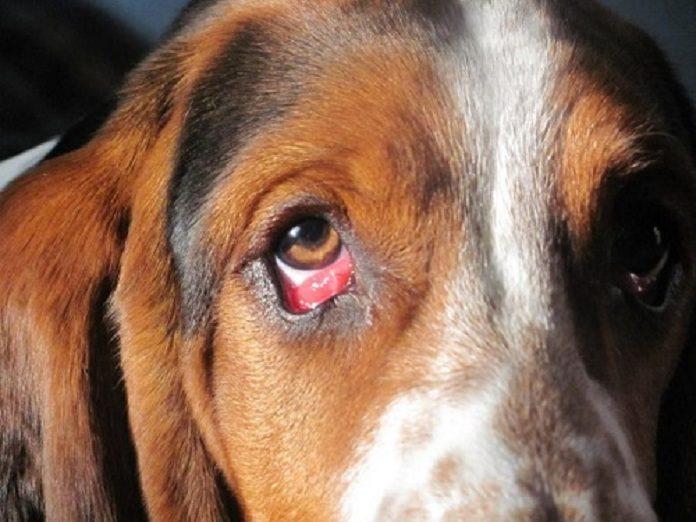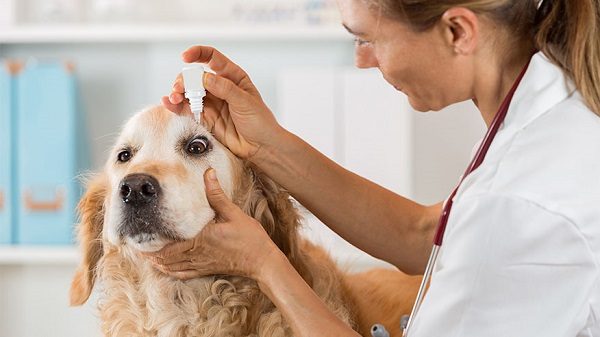Pink eye (conjunctivitis) is a fairly common disease in dogs, with the manifestation of red streaks and watery eyes, after a short time will appear yellow-green discharge, more severe will mucus, pus discharge. So what to do if a dog has red eye? What causes red eyes in dogs? Let's find out now.
Symptoms of pink eye disease in dogs

The conjunctiva is the area in front of the dog's eyeball and eyelids. When the conjunctiva becomes inflamed or infected, it will lead to pink eye. This disease is quite common and can go away on its own. However, if not cured, they can infect deeper areas of the eye and leave severe sequelae.
Symptoms of pink eye in dogs include red streaked eyes. When severe, the eyelids swell and stick together or secrete a lot of mucus, making the dog's eyes sensitive to light, so they will find a dark place to lie.
Pink eye usually occurs in dogs between the ages of 2 and 5. Dogs as young as 1 year old can also get this disease. The younger the dog, the faster the disease develops, and it occurs in almost all dog breeds.
In the early stages of the disease, the outer corneal area of the eye will become hematoma forming red or white fleshy tissue. There are also cases where it starts from the inside of the cornea. If not treated in time, the condition will get worse and cause the entire cornea to be damaged and lead to blindness.
Causes of red eyes in dogs
There are many underlying causes that lead to dogs having red eyes such as ultraviolet light, fog, etc. Dogs living in high-rise apartments, the distance from where they live to the ground is too far, and they are prone to disease. This is better than dogs living in the lower floors. And when you get sick, the condition will also be much more serious. According to some studies, the irradiation of ultraviolet rays will make the antigens of the cornea sensitive, susceptible to changes and infections.
Another cause is due to environmental factors such as dust, chemicals, scratching or scratching the cornea, causing irritation to the dog's conjunctivitis. Inflammation in the conjunctiva easily leads to the penetration of bacteria, viruses, and fungi into the dog's eyes.
In addition, pinkeye in dogs can also be caused by ingrown hairs, prolonged corneal dryness, or as a result of Care's disease, an infectious hepatitis disease. Therefore, if you see a dog with a corneal ulcer, the owner needs to take them to the veterinarian immediately to be diagnosed and treated promptly, to avoid delay, there will be a deep corneal ulcer, causing an intraocular cap leading to a perforation of the cornea. blindness and blindness.
Dog has red eye what to do?
Dog has red eye what to do? For To treat pink eye in dogs, we first need to control the pathogens and prevent blindness. In severe cases, your veterinarian may use specific medications to reduce inflammation inside the eye.
For example, use Cortisone ointment or eye drops. Depending on the stage of the disease, there is a corresponding treatment. In some cases, dogs with pink eye caused by keratitis may require lifelong medication.
If the dog has a corneal ulcer, the owner should not arbitrarily use eye drops but consult a veterinarian, be cautious and pay attention to keep the dog's eyes healthy.

If the dog only has common keratitis, the owner can continue to treat it for a few days until the disease is in remission. But there are also dogs that need to be treated for several weeks. If there is too much corneal precipitate that is obstructing vision, you must take your dog to surgery to correct it.
On the other hand, changing lifestyle habits can also control the development of the disease. For example, let your dog go outside to avoid ultraviolet rays. Owners can take them for a walk in the morning, in the garden, in the shade. Especially, families in high mountains or near the sea, where ultraviolet radiation is very strong.
You can also teach your dog to wear glasses to avoid ultraviolet rays, or use UV-blocking eye drops. Before giving a treatment plan for a corneal ulcer, your veterinarian will do a quick diagnostic test. From there, assess the degree of superficial or deep ulceration of the cornea. Only then can it be decided whether to choose a medical method, or to combine both medicine and surgery to bring good results.
In severe cases, the doctor will prescribe systemic antibiotics combined with specific antifungal or antibacterial eye drops. During treatment, dogs need to wear an anti-lick ring to protect their eyes from scratching, rubbing their eyes against the wall makes corneal ulcers worse. Treatment time usually takes 2-4 weeks for the cornea to recover.